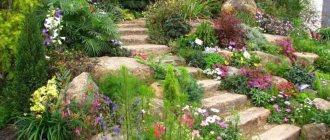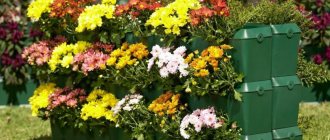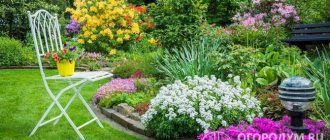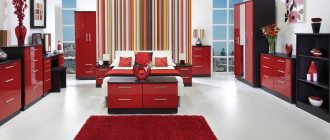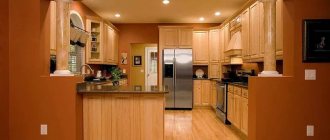What are vertical flower beds
A vertical flower garden cannot be called know-how; this method of landscaping has long been successfully used by city services in many localities.
With the same success, a similar method of organizing flower beds can be used in private areas.
Even if the area allows and the territory pleases with rose gardens, flower beds and green plantings, vertical flower beds will add their own flavor to the organization of the landscape, allowing you to zone the area and focus attention on something.
To make raised flower beds, you will need some materials and a little imagination.
Alpine slide
This is a miniature rock garden. The main task when constructing a rock garden is to ensure that it fits organically into the landscape . It is worth remembering that this style of garden art originated in ancient Japan.
The Japanese, above all, value harmony and peace
Alpine slides have gained unprecedented popularity in our time. Apparently our people lack quiet contemplation of natural beauty.
Making a good rock garden is not as easy as it seems at first glance
Planning should proceed in several stages. First of all, it is necessary to organize there is natural planning; it, as it were, stylizes the motifs of the mountain landscape.
- Choose areas with a slope or terraces.
- First, drainage is done, because mountain plants do not tolerate stagnant water.
- The top layer of soil is removed, buried 20–25 cm, crushed stone or broken brick 5–10 cm thick is laid.
- The stones should be matched in color and laid parallel to the surface of the site; stones should not be piled up chaotically.
- Use sandstone, limestone, granite, natural stones. Avoid regular shapes and right angles.
- The stones need to be installed firmly, because in the future it will be possible to move along them, weeding and loosening the rock garden.
- Fill the space between the stones with decorative pebbles or mulch with large sawdust and pine needles.
Stones are an integral part of the alpine slide
Install the stones firmly, you will have to climb on them while weeding the alpine slide
Places for installing flower beds
For vertical compositions with flowers and greenery there are no frames limiting the size or shape, so they can be placed literally anywhere in the summer cottage:
- a cascading flower bed will decorate the entrance area to the house, to the terrace, to the gazebo;
- You can decorate the fence with boxes of flowers and greenery, making the border less official;
- a flowerbed hidden in a bush, cascading or vertical, will enliven the corner during the period when the flowering of the bush ends;
- tall towers will brighten up the corners of the site;
- Hanging flowerpots, in a certain geometric or chaotic order, will look elegant not only at the entrance to the house, but also on the wall, near the bench.
Depending on the type of construction, there are:
- wall;
- wall;
- ground;
- hanging flower beds.
In a word, any boring corner can be enlivened by arranging even a low vertical of several pots or flowerpots.
Color combination: what is best to plant with?
The summer resident decides on his own how to beautifully make a flowerbed at the dacha and what flowers to plant. But you must take into account the recommendations of professionals:
- against the backdrop of tall bushes, any varieties of shrub roses look delicately and delicately;
- ground cover plants (European hoofweed, sedum) exquisitely emphasize the beauty of low-growing flowers (gatsania, elecampane).
When creating a composition, you need to focus on the shades of buds/foliage.
Flowerbed of hydrangeas at the dacha
Square multi-level flowerbed at the dacha
Advantages and disadvantages
Vertical flower beds have their pros and cons. The latter are solvable and not so critical as to give up the idea of using original, fresh solutions in landscape design.
Advantages:
- saving space. Arranging pots or boxes one above the other allows you to place a large number of plants in a relatively small area;
- the proximity of crops that in the open ground interfere with each other or “are at enmity.” It's no secret that not all plants can be planted nearby. A completely natural struggle for minerals and water arises when the fittest survives. Vertical solves such problems;
- in pots or other containers planted with flowers, practically no weeds grow (especially if the soil has been prepared in advance), there are no pests;
- originality of construction and individual design will make the site different from others.
Flaws:
- a small volume of soil requires regular fertilizing;
- outside, the soil in pots dries out quickly, there is no groundwater, so frequent watering of the plants is required to maintain the beauty of the greenery and flowering;
- In winter, the roots of perennials left outside freeze very much. It is recommended to make the structure collapsible (containers with flowers are removable) in order to put them in the basement or cellar during the cold period.
Selection of planting material
The flowerbed will look beautiful if the flowers in it are combined correctly. Plants should be planted in spring, wisely combining contrasting colors.
Tall or bushy plants should be planted in the center. Stock roses or hydrangeas will look great in large oval or round flower beds. Large bulbous plants can be placed around: gladioli, lilies, irises.
They need more space as they can grow. Knowing how to properly arrange a flower bed with lilies and gladioli, you can create a real masterpiece of floriculture art.
Types of vertical flower beds
Ideas for vertical flower beds can be gleaned from the Internet, but you should not limit yourself to ready-made forms: if you add imagination, you will be able to create your own, individual project.
flower tower
The flower garden, decorated in the “tower” style, has an absolutely stunning view. Strictly speaking, the shape of the tower can be any you choose: spherical, spherical, cubic, arbitrary. The main thing is that the tower is a figure filled with soil in which plants are planted. During the flowering period, it is completely covered with petals and the frame is not visible at all.
Flower ball
Special frames are sold for flower balls; you can build something similar with your own hands. The ball is filled with soil into which the plants are planted.
On the ground, the flowerbed will not look as advantageous as it does in limbo. During the flowering period, raised and suspended “balls” immediately attract attention.
Screen
As expected, a screen is used to disguise unattractive walls, boring buildings, or to zone a site. A wooden, plastic, metal “screen” planted with bright fragrant flowers will cope with its role perfectly.
Blooming pillar
The design resembles a “tower”, but unlike it, it has a strict cylindrical shape. The column can be organized in the form of a cascade, but, as a rule, it is a hollow cylinder with an organized irrigation system, planted with flowers.
Tunnel
The “tunnel” type design looks very original - high metal arches, “covered” with containers with plantings on top. Despite its unconditional beauty and originality, such a flower bed is very difficult to water; this must be taken into account in advance. Although, of course, the hanging species planted on the “roof” of the tunnel are a unique sight, such decor is used to organize various types of special events.
Hanging flowerpots
The simplest, and therefore the most common type of vertical flowerbed with your own hands is a support on which hanging pots with soil and plantings are attached. They can be placed anywhere on the site, using a fence, beams of a house or other buildings, even garden trees for the frame.
Topiary
A bright and original decoration of the local area are bush sculptures. Experiments with form here can only be limited by the imagination of the owner of the site. Balls and pyramids coexist with fairy-tale characters, animal figures with labyrinths. Simple forms look better next to the house; fancy ones should be given a grand place in the center of the site.
The basis for topiary is often coniferous crops, but there are many suitable plants among deciduous shrubs. Elm, linden, hawthorn, barberry, honeysuckle, etc. are suitable. For simple flower beds, it will be enough to trim the bushes in time; for more complex ones, you will have to build a metal frame.
Posting rules
When creating a flowerbed, you should adhere to several recommendations. They will help make the design harmonious.
- You should not chase the abundance of species and number of plants. An overloaded flower bed looks sloppy, and flowers that are planted in vertical structures suffer from a deficiency of minerals and water. When planting plants, you need to make gaps of 5-7 cm between them.
- Three to five plant species for one “tower” is optimal.
- The colors of the buds should be combined and in harmony with each other, in addition, you need to think about whether the plants will bloom at the same time or replace each other.
- Gaps and voids can be disguised with the help of decorative elements, greenery, and grass.
- It is necessary to give preference to plant species with a shallow root system; they will do well in a limited space.
Coniferous compositions
Tall conifers are unlikely to be suitable for a house flower bed, because...
an overgrown tree will block light, and the roots will not have enough free space. But compact junipers, dwarf varieties of fir, and neat thujas can be used to decorate a flower garden. Such flower beds are unpretentious and equally attractive at any time of the year. The most suitable option for a flower bed along the house is a horizontal composition. The basis is made up of plants of the same height. For low flower beds, mountain pine, Cossack juniper, Alberta Glob spruce are suitable, for higher ones - Lawson cypress, Compacta Glauka pine, etc.
If there is a task to block excess light or to cover the facade as much as possible from prying eyes, you can build a hedge from conifers. The task can be easily accomplished by thuja, which can be planted alone or in company with barberry.
Types of purchased structures
Today, specialized stores offer a wide range of ready-made designs that allow you to quickly and easily make a vertical flower bed with your own hands. These include wooden multi-level “pyramids” that can be moved around the site; wooden “ladders” with pallets; decorative flower pots and stands; pallets, metal and wooden boxes of various sizes; metal balls made of wire.
If you wish, you can realize your own needs and fantasies by making a custom-made structure based on an individual project. The only negative is the cost of such structures. Therefore, summer residents simply make do with what they have at hand, turning even household garbage and waste into stunning flower beds.
Laying a rock garden
If the plants you plan to plant like acidic soil, add peat chips, and if they prefer alkaline soil types, then you need to lim the soil with lime.
It is not recommended to use manure and large amounts of nitrogen fertilizers, as the plants will begin to vegetate wildly, this will give them an unusual appearance, they will stretch out, become unstable to diseases and lower temperatures.
In addition, manure can contain a huge amount of weed seeds, and as you know, weeds are the worst enemies of flower beds.
Early flowering crocuses take pride of place on alpine hills
In the first 2 - 3 years you can not apply fertilizers at all; in subsequent years you need to add a little superphosphate.
The range of plants used for alpine slides is very wide
Cereals:
- ground cover plants
- all kinds of bells (Carpathian bellflower, Campanula angustifolia)
- Heuchera
- looked younger
- bloodroot
- saxifrage
- savory
- lavender
From early flowering plants you can plant:
- crocuses
- saffron
- decorative bow
- hazel grouse
- hyacinths
Single growing ferns will look beautiful.
Among the shrubs there are many attractive low plants that are suitable for decorating an alpine slide:
- barberry
- heather
- rhododendron
- low growing spirea
- euonymus
- boxwood
Sedum and young - a standard set for a top-end rock garden
Coniferous plants look beautiful: decorative low-growing Christmas trees, pines, yew, juniper.
How to make a vertical flowerbed with your own hands using improvised materials
Creating flower beds with your own hands at the dacha is not at all difficult. You can use everything that has long been asked to be thrown into the trash, but for some reason has not yet gone there. It's time to give old junk a second life.
From plastic bottles
Even first-graders know that plastic takes centuries to decompose. But if separate waste collection is organized in the city, when recycled plastic containers are recycled, then problems arise with this outside the city. And there are quite a few bottles of water and drinks collected in the country house. It's time to use them for a good cause.
- Five-liter drinking water bottles are very convenient. They need to cut off the neck or bottom (and turn them over by screwing on the lid) to create a wide, capacious container.
- Two-liter bottles are also cut to half (they often use half with a neck, hanging the lid down, such pots look impressive).
- The bottle can be placed horizontally by cutting out a spacious hole on one side for soil and planting flowers.
Bottles with plantings can be mounted on a fence, wall, or used to decorate a screen.
From the boxes
Boxes made of wood or plastic are naturally ideal containers for organizing a flowerbed with your own hands. Boxes of different sizes can be placed vertically on top of each other (after filling them with soil), and seedlings can be planted in the resulting gaps, thus creating a cascading flower garden.
If the boxes are the same size, then plants can be planted in the spaces between the slats or in the side holes.
The boxes can be placed on the ground, nailed to a wall, mounted on a fence, or used to make decorative “border” posts.
Made from metal mesh and garden film
If you cut off about a meter of chain-link mesh, cover it from the inside with thick plastic film or black spunbond, securing it in the corners, and then roll the mesh into a cylinder and connect the edges, you will get the basis for a high flower bed. You need to make holes in separate cells (in a checkerboard pattern) in which flowers will be planted.
The cylinder is placed in a wooden or plastic container (bucket) and firmly fixed (you can bury the bucket in the ground). You need to install a plastic pipe in the center, first drilling holes in it for irrigation and sealing the bottom hole (which will stand at the bottom of the bucket). The gaps between the walls and the pipe must be filled with soil mixture and flowers planted.
From geotextile
Geotextiles are a convenient material for making a vertical flower bed. The frame is made of reinforcement bars installed in a circle. On the outside, they are wrapped in several layers of geotextile; holes for seedlings need to be made in it in random order.
The watering system is the same as in a flowerbed made from a chain-link mesh: in the center there is a plastic tube with holes for water, with an insulated bottom edge. The space between the geotextile walls and the water tube is filled with soil. In both cases, it is recommended to make a drainage layer at the bottom.
From a pallet
Wooden pallets are a convenient, eco-friendly material that will last a long time faithfully. Pallets can be used to make a wonderful screen or raised flower bed.
In the first case, the pallet must be turned with its back (“legs”) forward, and using small nails or a furniture stapler, secure the geotextile folded in several layers so that it forms a bag. Pour soil into it and plant flowers.
Put together a kind of box from several pallets and plant flowers in it, raising them above the ground.
Pallets must be sanded and covered with a colorless or decorative protective material. You can decorate a flower bed made of wooden pallets with colored paints.
Using other items
By “other items” we mean everything that is lying around underfoot. For example, old shoes. Daisies will look great in rubber boots and galoshes nailed to the fence. Petunias will look great in an old umbrella turned upside down with its handle. Violets look very cute in small cups suspended one above the other. You just need to look around and use your imagination.
Watering cans, buckets, basins
There is also plenty of this goodness in the dacha! They can be raised above the ground by installing them on stands, stumps, steps, benches, or, on the contrary, dug into the ground.
You can also add old pots, deep frying pans, boiling pots and buckets here. The main thing is not to forget to water the plants. And remember that metal “flower beds” are subject to corrosion from contact with water, so you need to monitor their condition.
Tires and Tires
Car tires and tires are classics of country house decor; they have been used for a long time to fence flower beds.
But if you stack the tires on top of each other, or in some other order, and fill the voids with soil, plant plants, and you will get a vertical flower bed. Tires can be dug into the ground, hung on a tree, cut into two parts and attached to each of them on a wall (fence). Tires can be painted in different colors, braided with decorative cord, and turned into flowerpots.
Plastic pipe
You can make a pillar or tower from a plastic pipe of a suitable diameter: you need to cut holes in it in a checkerboard pattern (5-6 cm in diameter). Inside, in the center, place a pipe of smaller diameter with holes drilled in it.
Fix the structure in the ground, fill the pipe cavity with soil and plant the seedlings in the prepared holes. The inner thin pipe is designed for watering.
Pots and containers
It’s very easy to organize a vertical flower bed with pots and containers: they need to be secured in “floors” or in a cascade on a fence, wall, or wooden pallet; you can build a pole with hooks and hang pots; containers can be installed on special stands, shelves - in a word, you can give free space to your imagination. Pour soil into pots and containers and plant flowers. Bright colors of pots will make the flower bed attractive.
Barrels and containers
You can also organize a flower garden in wooden barrels and tubs. To do this, you need to install a watering pipe in the central part, fill the barrel with soil, cut holes in the sides with a diameter of about 5 cm and plant the plants.
Bulb flower beds
Tulips, crocuses, daffodils, and goose onions are often used to frame garden paths, fences and decorate areas near walls. Most of them bloom with the melting of snow and the first warmth of spring, and are distinguished by their bright colors and pleasant aroma.
The flowering time of bulbs varies dramatically, therefore, by combining several plants in a flower garden, you can get a flowerbed of continuous flowering. Tall varieties are placed closer to the facade, and low varieties are placed further away.
How to choose suitable flowers for vertical flower beds
Choosing suitable plants is a crucial moment in organizing a vertical flower bed. The appearance of the flower garden and the corner where it will be installed depends on how correctly and successfully they are selected.
It is recommended to choose plants that are unpretentious, easy to care for, resistant to rain, drought, disease and temperature changes, do not grow very much, and have a shallow root system.
Annuals are preferable to perennials, despite the fact that seedlings will have to be grown every year. Especially if we are talking about a stationary flower bed without the ability to put the containers away in the basement or cellar for the winter. The root system of flowers freezes strongly and they may die. An exception can be made in southern regions with warm winters.
But the main thing is to select plants that will delight the eye with long, abundant flowering, bright or delicate buds.
Petunias
Classics of the genre - petunias. The variety of shades in which the bell-shaped petunia flowers are painted is amazing:
- white,
- soft pink,
- scarlet,
- lemon,
- raspberry,
- lilac,
- purple,
- with stripes,
- motley,
- two-color.
Large and small, erect and ampelous, petunias cover the soil with a bright carpet and bloom desperately until frost (with proper, not very difficult care).
Nasturtiums
Yellow and red nasturtium flowers will decorate any flower bed. Curly shoots will entwine the vertical structure, hiding the frame under spectacular greenery and wide leaves.
The flowers are double and semi-double, but both are very beautiful and fragrant.
Lobelia
Such a changeable lobelia has recently become a favorite of gardeners again. Its small fragrant flowers (bluish, pink, white) decorate the flower garden for a long time.
Lobelia has cascading, ampelous, and compact varieties; it is unpretentious in care.
Balsams
With their dark green fleshy foliage, translucent stems and bright flowers, they have become popular again, only now as outdoor plants.
They feel great in flower beds, bloom for a long time and do not cause problems. There are many varieties, you can choose the one you like best.
Nemesia
It seems like it was specially created for voluminous textured flower beds. Flowers with a tubular corolla can be painted in a variety of colors: white, pink, yellow, red, blue, or a combination of two colors. They are quite heavy and under their weight the stems bend, hanging beautifully.
Godetia
Neat, erect godetia bushes grow up to half a meter in height; it is important to form a crown in a timely manner.
Simple or double flowers are bell-shaped, painted white or one of the shades of red; some varieties have complex combined coloring of the petals.
Begonia
Begonia is extremely popular in garden floriculture. It is hardy, unpretentious, and is used not so much for its inconspicuous small flowers (although many people like them), but for its decorative, variegated leaves.
As a rule, evergreen begonia and tuberous begonia are used for landscaping.
Coleus
Unsurpassed in its decorativeness, coleus is truly amazing. Its leaves, depending on the chosen variety, can be greenish, lemon, yellow, pinkish, crimson, purple, and have a contrasting edging.
The combination of coleus of different colors makes the flower bed a real miracle. Coleus are unpretentious and extremely easy to care for.
Brachycoma
Brachycoma looks simple but elegant in a vertical flowerbed. This plant has delicate thin foliage and branches well, quickly growing over the given area.
It blooms with small white, blue, bluish or lilac flowers, collected in baskets of four.
Alyssum
People affectionately nicknamed him “Alyssum.” Alyssum can often be found in country house design.
The low (up to 40 cm) stems of alyssum are highly branched and become woody at the base. Small fluffy flowers are collected in inflorescences and can be colored white, yellow, pink, red or purple.
The pronounced spicy, sweetish aroma attracts pollinating insects.
Eschszolzia
A distant relative of the poppy. Its flowers are painted milky white or deep yellow.
Even though the “lifetime” of one bud is three days, there are a lot of flowers and flowering in general lasts a long time, which is why eschscholzia is a favorite of many gardeners.
Marigold
Old friends, but still beloved marigolds can bloom for quite a long time without special care. Numerous varieties - tall and short, with large heads and small flowers, delight the eye until late autumn, saturating the air with a spicy, tart, bitter aroma.
Pansies
These flowers also do not need any special introduction. These low-growing flowers with stunning “velor” buds of complex colors are not in vain loved and grown in flower beds for so many years.
Pansies begin flowering early, which continues until mid-autumn; they are unpretentious and very beautiful.
Greenery
Not only flowers, but also greens are used as plants for a vertical flower bed:
- ferns,
- daylilies,
- cereals,
- strawberries,
- succulents,
- bindweed (dichondra).
Rabatka
A rabatka is a long strip of land planted with ornamental plants.
Rabatki are good for arranging garden paths and alleys
They highlight the foundation of the building well. As a rule, ridges are not wide up to 2.5 meters.
There is no need to do very long work. If you need to plant a fairly large area, then simply make gaps of half a meter between the ridges.
Plant the gaps with low-growing shrubs: boxwood, spirea.
According to the height of the plants, ridge plants are divided into two types:
1 One-sided - in this case, low plants are planted on the front side of the ridge, then taller ones and, finally, the tallest ones in the background.
2 Double-sided - in this case, tall plants are located in the center, and low plants are located at the edges.
According to the color scheme, discounts are divided into single-color and multi-color.
When creating single-color flower beds, garden plants of the same type and color range are used. In multi-color discounts, you can combine different colors at certain intervals. Multi-colored discounts are more attractive and elegant.
Features of caring for flowering plants in vertical cascade containers
Since each plant exists separately in vertical cascading flower beds, it becomes possible to plant plants with different care requirements side by side. These are the requirements that need to be met.
- To prevent moisture from leaving too quickly through wooden or wicker containers, film or geotextiles are placed in them.
- When organizing vertical plantings, it is recommended to add material to the soil that makes the soil loose. For example, it could be compost, peat, perlite, sand. In addition, it is necessary to organize a drainage layer in them (at least 10 cm). This is done for proper distribution of moisture.
- Since plantings in a vertical flowerbed have to be watered more often, it is advisable to organize a drip irrigation system. For example, using plastic pipes with holes. It is also convenient to feed plants with liquid preparations through them.
- Despite the fact that most of the plants recommended for planting are annuals, perennial crops are also used. However, they need to be protected from freezing during the winter. Cover stationary structures with spruce branches or non-woven material. It is advisable to put collapsible ones in the cellar at a temperature of about 0ºС. There is no need to keep the pots warm to prevent the plants from growing.
- Fertilizing should be frequent and regular to compensate for the deficiency of minerals in the soil.
- You also need to regularly inspect plants for diseases, pull out weeds, and pick off wilted buds.
Mixborders
Combined mixborder along the fence
Mixborders are multi-row flower beds of ornamental plants . The plants are selected so that when some fade, others immediately bloom, and the mixborder remains attractive throughout the season.
A flower bed that is attractive in the off-season is the pinnacle of a florist's skill
Mixborders are often placed along buildings, on lawns, and near swimming pools in the form of bright color spots. The edges of the mixborder are limited to lawn grass or laid out with tiles, stones, and stump cuts.
Perennial cereal grasses look beautiful in mixborders
The selection of plants should be such that the flower garden will be a decoration throughout the entire summer season. For mixborders, annuals and biennials are used, but the main place, of course, belongs to perennial plants.
Use pebbles to fill empty spaces between plants
The background for a mixborder can be:
- pampas grass bush
- tree peony
- barberry
- dogwood
- small beautiful flowering tree
Combined mixborder along the fence
Photos of vertical flower beds
Photos of vertical flower beds should not only be admired, they should serve as a source of inspiration for creating your own masterpieces in your summer cottage.
Soil preparation
It is advisable to prepare the soil 3 to 5 weeks before planting flowers in the flower bed
- Provide good drainage. Standing water negatively affects the physiology of flowering plants.
- Perennial plants can go into a state of suspended animation due to waterlogging.
- There must be air in the soil, the soil must be moisture-absorbing and fertilized.
- If there are a large number of weeds, you need to remove them, dig up the ground, and get rid of the roots of perennial grasses, especially the rhizomes of creeping wheatgrass.
- Organize drainage, lay it to a depth of a couple of bayonets of a shovel.
- Compost, humus, and peat chips have a beneficial effect on the quality of the soil.
- If your site has clay soil, you need to add sand and half-rotten sawdust.
Watering
The best time to water is early morning
In summer, perennial flowers need to be watered often and in large quantities. If they lack moisture, they will bloom poorly and will not have the desired aesthetic effect.
Do not water the plants on the leaves, pour water directly under the roots, this way you will avoid the spread of powdery mildew.
Do not forget to remove faded branches, inflorescences, and leaves that have lost their attractiveness. Try to keep your flowerbed decorative for as long as possible.
Layout
Perennials are grouped by growth, flowering time, color, and type of leaves. Choose plants that are not particularly labor-intensive to care for.
Moderately labor-intensive perennials include:
- astilbe
- aster
- geranium
- primrose
- brachycoma
- cloves
- sedum
Foxglove requires virtually no care
Among the unpretentious ones the most popular are:
- monarda
- stock-rose
- digitalis
- lily of the valley
- digitalis
- lavender
- phlox
- lovage


